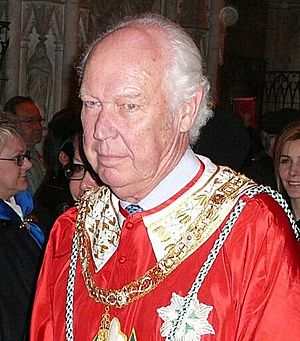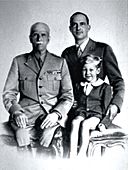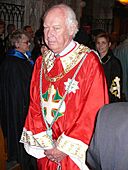Vittorio Emanuele, Prince of Naples facts for kids
Quick facts for kids Vittorio Emanuele |
|||||
|---|---|---|---|---|---|
| Prince of Naples Duke of Savoy (disputed) |
|||||

Vittorio Emanuele in 2013
|
|||||
| Head of the House of Savoy (disputed) |
|||||
| Period | 18 March 1983 – 3 February 2024 | ||||
| Predecessor | King Umberto II | ||||
| Successor | Prince Emanuele Filiberto | ||||
| Born | 12 February 1937 Naples, Kingdom of Italy |
||||
| Died | 3 February 2024 (aged 86) Geneva Cantonal Hospital, Switzerland |
||||
| Burial | Basilica of Superga | ||||
| Spouse |
Marina Doria
(m. 1971) |
||||
| Issue | Emanuele Filiberto, Prince of Venice | ||||
|
|||||
| House | Savoy | ||||
| Father | Umberto II of Italy | ||||
| Mother | Marie-José of Belgium | ||||
Prince Vittorio Emanuele of Savoy, Prince of Naples (born 12 February 1937 – died 3 February 2024) was the only son of Umberto II. Umberto II was the very last King of Italy. His mother was Marie-José of Belgium.
Vittorio Emanuele also used the title Duke of Savoy. He claimed to be the head of the House of Savoy. This is a very old royal family. However, some people disagreed with his claim. They supported his cousin, Prince Amedeo, and later Amedeo’s son, Aimone.
Vittorio Emanuele lived most of his life away from Italy. This was because of a vote in 1946. In this vote, people decided to end the monarchy. They chose to create the Italian Republic instead.
Contents
Early Life and Family
Vittorio Emanuele was born on 12 February 1937 in Naples. His father was Umberto, Prince of Piedmont. His mother was Princess Marie-José of Belgium. His father later became the last King of Italy.
After the monarchy ended in 1946, the royal family had to leave Italy. They lived in other countries, mostly in Switzerland and Portugal. Vittorio Emanuele lived with his mother in Switzerland. His family lived in Geneva.
Vittorio Emanuele married Marina Doria on 7 October 1971. Marina was from Switzerland. She was a world-ranked water skier. They got married in Tehran, Iran. It was during a big celebration for the Persian Empire. Vittorio Emanuele and Marina shared the same birthday, 12 February. Marina was two years older than him.
Vittorio Emanuele worked as a banker and an aircraft salesman.
Vittorio Emanuele had one son. His name is Prince Emanuele Filiberto of Savoy, Prince of Venice. He was born on 22 June 1972. Emanuele Filiberto has two daughters.
Dispute Over the Duke of Savoy Title
On 7 July 2006, a relative named Amedeo, 5th Duke of Aosta said he was the head of the House of Savoy. He also claimed the title of Duke of Savoy. Amedeo said that Vittorio Emanuele lost his right to the title. This was because he married without his father's permission in 1971. Vittorio Emanuele's sister, Maria Gabriella, supported Amedeo.
Vittorio Emanuele and his son went to court. They wanted to stop Amedeo from using the title "Duke of Savoy". In 2010, a court in Arezzo ruled that Amedeo had to pay money to his cousins. The court also said he should stop using the last name Savoy. However, this decision was later changed. Another court allowed Amedeo to use the short name di Savoia. It also removed the financial penalty.
Life in Exile and Return to Italy
Why the Royal Family Left Italy
The Italian Constitution was created in 1948. It said that all male members of the House of Savoy had to leave Italy. They were not allowed to return. This was a "temporary rule" at the time. The constitution also said that Italy must always be a republic. This meant the monarchy could not easily return.
Efforts to Return Home
Vittorio Emanuele tried for many years to return to Italy. He talked to the Parliament of Italy. In 1999, he took his case to the European Court of Human Rights. He said that being in exile for so long was against his human rights.
To be allowed back, he gave up any claim to the old throne. He also gave up any claim to Italy's crown jewels. He told the Italian government that the royal properties "are no longer ours". He said, "We have nothing in Italy and we are not asking for anything." He also stopped his case at the European Court of Human Rights. In 2002, Vittorio Emanuele and his son wrote a letter. In it, they promised to be loyal to the Constitution of Italy.
Coming Back to Italy
On 23 October 2002, the rule that stopped male royals from returning was removed. Vittorio Emanuele agreed to give up all claims to the old throne. He also recognized the Republic as the only legal government. He was allowed to enter Italy on 10 November 2002.
On 23 December 2002, he made his first trip home in over 50 years. He, his wife, and his son visited Pope John Paul II at the Vatican.
In 2003, they visited Naples, where Vittorio Emanuele was born. The people of Naples had mixed feelings about their return. Some people did not care. Some were against it. A few were supportive. News reports said that many in Naples were not happy. Hundreds of people protested as they walked through the city. The protests came from two groups. One group was against the monarchy. The other group supported the House of Bourbon-Two Sicilies. This was another royal family that ruled before Italy was united in 1861.
Death
Vittorio Emanuele died on 3 February 2024. He passed away in Geneva Cantonal Hospital, Switzerland. He was 86 years old.
Succession
In June 2023, his son Emanuele Filiberto said he might give his claim to the throne to his daughter. Her name is Princess Vittoria of Savoy. He said he would do this when she is ready. Until then, he remains his father's heir.
Honours
| Styles of Prince Vittorio Emanuele |
|
|---|---|
 |
|
| Reference style | His Royal Highness |
| Spoken style | Your Royal Highness |
Vittorio Emanuele was the leader of the special groups called Dynastic Orders of the House of Savoy. These groups give out awards and honours.
National Honours
 Sovereign Military Order of Malta: He was a special Knight Grand Cross of the Sovereign Military Order of Malta.
Sovereign Military Order of Malta: He was a special Knight Grand Cross of the Sovereign Military Order of Malta. Two Sicilian Royal Family: He was a Knight Grand Cross of the Two Sicilian Royal Sacred Military Constantinian Order of Saint George.
Two Sicilian Royal Family: He was a Knight Grand Cross of the Two Sicilian Royal Sacred Military Constantinian Order of Saint George.
Foreign Honours
 Greek Royal Family: He was a Knight Grand Cross of the Royal Order of the Redeemer.
Greek Royal Family: He was a Knight Grand Cross of the Royal Order of the Redeemer. Monaco: He was a Knight Grand Cross of the Order of Saint-Charles.
Monaco: He was a Knight Grand Cross of the Order of Saint-Charles. Montenegrin Royal Family: He was a Knight of the Order of Petrović Njegoš. He was also a Knight Grand Cross of the Royal Order of Prince Danilo I and a Knight of the Order of Saint Peter of Cetinje.
Montenegrin Royal Family: He was a Knight of the Order of Petrović Njegoš. He was also a Knight Grand Cross of the Royal Order of Prince Danilo I and a Knight of the Order of Saint Peter of Cetinje. Empire of Iran: He received a special medal from the 2,500-year celebration of the Persian Empire.
Empire of Iran: He received a special medal from the 2,500-year celebration of the Persian Empire.
Ancestry
| Ancestors of Vittorio Emanuele, Prince of Naples | |||||||||||||||||||||||||||||||||||||||||||||||||||||||||||||||||||||||||||||||||||||||||||||||||||||||||||||||||||||||||||||||||||||||||||||||||||||||||||||||||||||||||||||||||||||||||||||||||||||||||||||||||||||||||||||||||||||||||||||||||||||||||||||||||||||||||||||||||||||||||
|---|---|---|---|---|---|---|---|---|---|---|---|---|---|---|---|---|---|---|---|---|---|---|---|---|---|---|---|---|---|---|---|---|---|---|---|---|---|---|---|---|---|---|---|---|---|---|---|---|---|---|---|---|---|---|---|---|---|---|---|---|---|---|---|---|---|---|---|---|---|---|---|---|---|---|---|---|---|---|---|---|---|---|---|---|---|---|---|---|---|---|---|---|---|---|---|---|---|---|---|---|---|---|---|---|---|---|---|---|---|---|---|---|---|---|---|---|---|---|---|---|---|---|---|---|---|---|---|---|---|---|---|---|---|---|---|---|---|---|---|---|---|---|---|---|---|---|---|---|---|---|---|---|---|---|---|---|---|---|---|---|---|---|---|---|---|---|---|---|---|---|---|---|---|---|---|---|---|---|---|---|---|---|---|---|---|---|---|---|---|---|---|---|---|---|---|---|---|---|---|---|---|---|---|---|---|---|---|---|---|---|---|---|---|---|---|---|---|---|---|---|---|---|---|---|---|---|---|---|---|---|---|---|---|---|---|---|---|---|---|---|---|---|---|---|---|---|---|---|---|---|---|---|---|---|---|---|---|---|---|---|---|---|---|---|---|---|---|---|---|---|---|---|---|---|---|---|---|---|---|---|---|
|
|||||||||||||||||||||||||||||||||||||||||||||||||||||||||||||||||||||||||||||||||||||||||||||||||||||||||||||||||||||||||||||||||||||||||||||||||||||||||||||||||||||||||||||||||||||||||||||||||||||||||||||||||||||||||||||||||||||||||||||||||||||||||||||||||||||||||||||||||||||||||
Images for kids
Gallery
See also
 In Spanish: Víctor Manuel de Saboya (1937-2024) para niños
In Spanish: Víctor Manuel de Saboya (1937-2024) para niños







